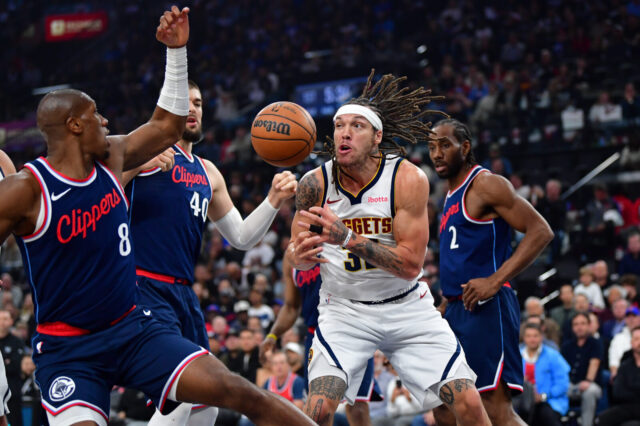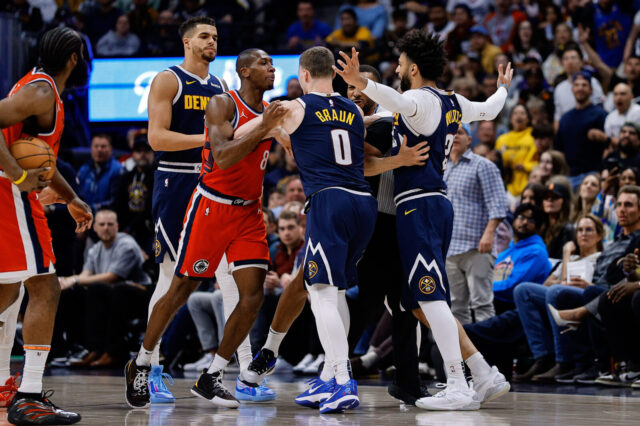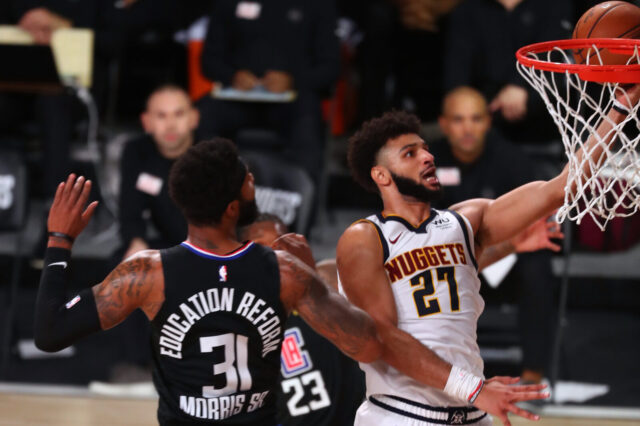If you’re not familiar with Film Fridays, each Friday, I’ll be looking at some recent Denver Nuggets’ games, lineups or something else from a film aspect to try and bring you a piece of content that you’re not getting somewhere else. Feel free to give any feedback positive or negative in the comments or find me on Twitter.
Early into December, the Denver Nuggets are dealing with injuries and struggling to get by. They’re currently sitting in 10th place in the Western Conference with a 10-11 record, although they remain just 1.5 games out of fourth place due to the entire conference being on top of each other in the standings. Denver has dealt with injuries to just about everyone on the roster. With all of those injuries, that forces the offense to find new ways to score points. One avenue that they haven’t explored a ton is the idea of getting Aaron Gordon more involved as a primary offensive weapon.
In limited minutes last season with the Nuggets’ full starting five, the lineup of Jamal Murray, Will Barton, Gordon, Michael Porter Jr. and Nikola Jokic had a net rating of +18.5. That was the 10th-best rating in the league among five-man lineups with at least 100 minutes together on the floor, with three of the nine lineups ahead of that grouping being variations of the Utah Jazz. With Porter Jr. and Murray still on the shelf, Denver should be looking to get Gordon more involved on the offensive end.
Gordon is a mismatch nightmare for opponents due to his combination of size and athleticism. He’s too big for smaller wings to manage inside, and he’s too fast for bigger wings to keep up with him in transition or when he’s slashing to the rim. Gordon is averaging just 10.4 shots per game, and the team could really use him in more ways to open up the offense with the shifts that they’re likely to go through rather than just playing the same style of offense despite players being out of the lineup.
Too Big for Fast Guys
This play is a perfect example of how Gordon is a mismatch for smaller defenders. Terrence Ross has decent size at 6’6” and 206 pounds, but he’s no match for Gordon’s size inside. Gordon catches the ball on the right wing on the pass from Jokic. Ross has decent positioning on Gordon, and he tries to go for the steal. Once he does that, Gordon is able to use his size to keep Ross away from the ball before eventually just ending up at the rim for the easy finish.
Same game. Different defender. Same result. Cole Anthony gets switched onto Gordon, and that matchup is over from the start. Anthony measures in at just 6’2” and 185 pounds, and Gordon can just bully him until he gets to the positioning he wants. Gordon uses his size to back Anthony off which forces Anthony to lean back into him, and Gordon then has the ability to just spin and throw down a huge dunk. How does Denver get Gordon more matchups like this? They need to run more screens for him when he’s the ball-handler with a guard setting the screen to generate the mismatch.
Too Fast for Big Guys
Remember, he’s too big for the fast guys AND too fast for the big guys. On this play, there are three defenders between Gordon and the rim. All three of them are 6’6” or taller, and two of them weigh the same or more than Gordon. With Jae Crowder closing out on him, Gordon catches the ball and drives to the rim through the three defenders. Deandre Ayton isn’t fast enough to rotate over to stop him from getting to the rim, and that gives him the free two points.
This play is a prime example of how Gordon doesn’t have to directly use his speed in order for his speed to affect his defender. Gordon gets the dribble hand-off from Jokic and uses the screen to get a switch where Steven Adams is guarding him. Adams has plenty of size, but he doesn’t have the speed or lateral quickness to stay in front of Gordon if he drives to the rim. Realizing that, Adams leaves Gordon plenty of space, and that gives him the easy look at the mid-range jumper. After knocking down that shot, that will force him to
Transition Can Be Your Friend
Gordon’s biggest strength might be his work in transition. With Jokic on the roster, this team isn’t going to be the type that runs and guns all game long and leads the league in pacing. However, getting Gordon on the run can be a giant problem for opposing defenses. On this play, Gordon plays defense on Luka Doncic and forces the miss. Once that happens, he turns around and grabs the rebound on the run. With a full head of steam, the defense is up a creek without a paddle, and they can do nothing other than hope that he misses when he goes up for the shot.
This play isn’t the stereotypical transition opportunity where Gordon is running against one defender. Instead, this play develops early in the shot clock with Jokic moving with a good amount of pace up the floor. Gordon does the work early to establish position under the basket, and that gives him an easy matchup against C.J. McCollum with no center help behind him. While the Nuggets can take their time getting up the floor, sometimes, it makes more sense to do the work early when the defense isn’t ready for it.
For those of you that are still here, remember to leave your feedback in the comments or over on my Twitter, and have a fantastic film-filled Friday.


